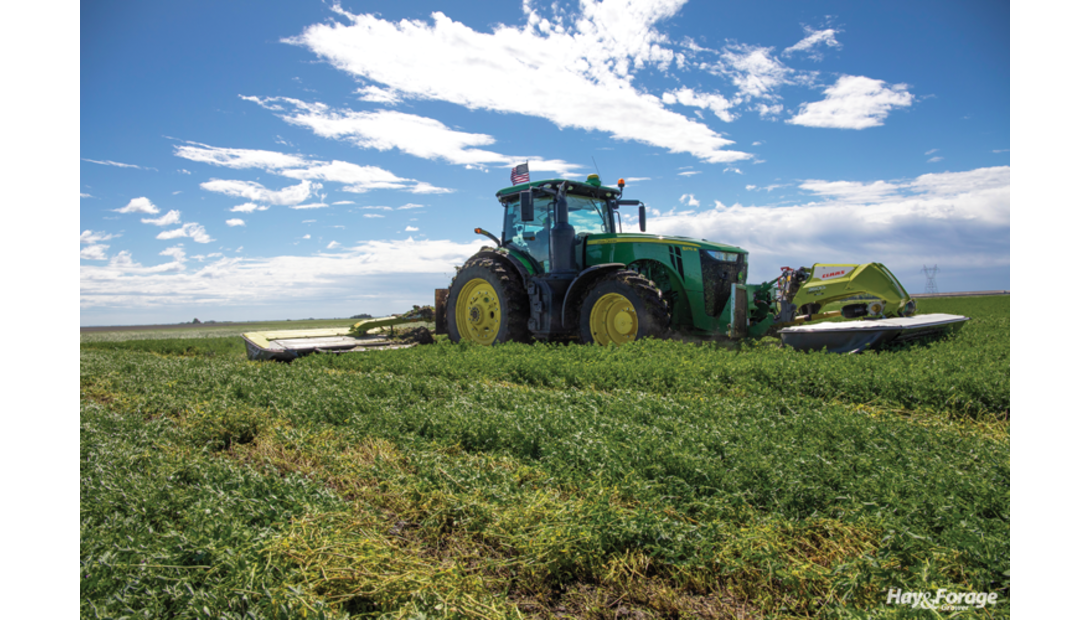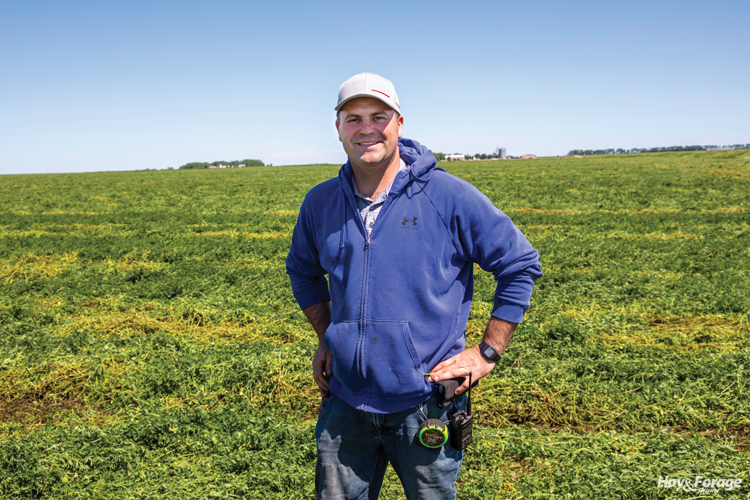
Taylor Gramm helps to oversee a custom harvesting business that has more forage harvesters than primary clients it chops for. Normally, that would seem like a business model destined for failure, but that’s not the case here.
Gramm works for C.R. Koehl & Sons, which is located in west central Minnesota, about 20 miles from the South Dakota border. The custom forage harvesting business that consumes his time is just one enterprise of the much larger 9,500-acre farm that grows and harvests organic and conventional corn, edible beans, sugarbeets, carrots, and alfalfa. They also run a 2,200-head feedlot, a large hog operation, and operate a feed supply retail outlet.
So how do you pull off owning and operating two large forage harvesters and associated harvesting equipment with only one client? That one client, Riverview LLP, owns two nearby dairies that milk 15,000 cows between them and require thousands of acres of feed.
Before coming to C.R. Koehl & Sons seven years ago, Gramm spent 12 years working for Riverview as a crop and forage harvesting manager. At that time, Riverview cut back on their ownership of harvesting equipment and Gramm’s current employer doubled their capacity from one forage chopping system to two. A system is defined as a chopper, two mergers, two dozer tractors, and five to eight trucks. Three triple mowers do the alfalfa cutting.

“Ninety-five percent of the chopping income comes from Riverview,” Gramm noted. “The remaining 5% is mostly for our own company’s feedlot and those of neighbors.”
Alfalfa provides a beneficial rotational crop for the vegetable growers in the area, including C.R. Koehl’s acreage. All of the alfalfa and corn silage harvested for the two Riverview dairies comes from land owned by area crop and vegetable farmers. “For our farm and others, alfalfa helps control diseases and weeds, especially on the organic acres,” Gramm explained. “We currently have about 10% of our acres in an organic program and are hoping to get to about 20% over the next few years. Alfalfa has been beneficial to that conversion process.”
A coordinated harvest dance
Gramm said their two harvest systems handle about 3,000 acres of alfalfa and 5,000 to 6,000 acres of corn for silage each year. Three Claas triple mowers and four Oxbo mergers are run ahead of two Claas 990 choppers for the haylage harvest. C.R. Koehl & Sons have four trucks of their own and contract with neighbors for the remaining units needed.
Although communication and coordination are always key when several forage harvesting outfits are harvesting at the same time in different locations for the same farm, corn silage harvest raises the stakes. “We all talk to each other every day so that we can stay in sync with each other,” Gramm said. “Riverview has a person that oversees their two farms in this county, and he looks at the big picture, determining how many choppers are needed for a given day and where. Our farm also has a person who monitors field maturity, and he stays in close contact with Riverview. We’re all like one big happy family,” Gramm chuckled.
When harvesting corn silage, the forage is chopped into large dump wagons, which then is unloaded into the waiting trucks at the field’s edge. The wagons also are used for haylage on an as-needed basis, usually when fields are wet. Each tracked dump cart can hold as much feed as a full semitrailer — about 24 tons of wet corn silage — and has its own scale. This eliminates having to run trucks across a drive-over scale on the farm, which saves time. “When everything is working, the chopper never stops,” Gramm noted.
With the dump-cart system, Gramm said that their truck repairs have gone way down, and it’s much easier to train truck drivers. The downside is that a 500 HP tractor is needed to pull the carts.
During the corn silage harvest season, choppers run around the clock. Employees are placed on one of two 12-hour shifts starting at 2 p.m. and 2 a.m. That’s adjusted on Sundays to help protect the employee’s day when no chopping occurs. “We try to be home by midnight on Saturday night,” Gramm said. “Nothing happens on Sunday.”
Local employees
Gramm said that they like to hire local people and family members that they already know. Many times, these are existing farmers who are also growing alfalfa and corn for the two local Riverview-owned dairies. “That gives them buy-in to the process,” Gramm explained. “Most of the people are area crop farmers who are just waiting to harvest their own crops. We often lease existing trucks, trailers, and packing tractors that otherwise are being used on other farms. We have few problems with people showing up late or not showing up at all. We try to keep them well informed ahead of when we’ll need them,” he added.
“The farm owners at C.R. Koehl & Sons like to hire a lot of young people, too, and train-up the next generation,” Gramm said. “We want to get them on the farm and teach them to love agriculture. When we hire high school-aged employees, there’s always an experienced adult with them.”
Like many farms, Gramm noted that their biggest barriers are labor and weather. “Finding enough people who can help you get ahead is the biggest challenge with labor,” he said. “There’s a lot of competition for good employees around here.”
Communication is a skill that is highly stressed at C.R. Koehl & Sons. “We talk all of the time so everyone knows what’s going on,” Gramm explained. “This helps keep people awake and alert. If an employee thinks they will sit in the tractor and listen to podcasts all day, they usually don’t make it with us,” he added.
Gramm said that they try to make their farm a desirable place to work and maintain a family atmosphere. “We all take a break time every day at 9:30 a.m. and 3:30 p.m., he explained. “Our wives will often fix meals and bring them out to the field, where we’ll pause and eat together.
“Employee safety is front and center every day,” Gramm asserted. “We bring up safety at every meeting and employees have the opportunity to share both their mistakes and ideas to make for a safer work environment. Rather than a safety policy, we try to instill a safety attitude,” he added.
This article appeared in the July XL 2024 issue of Hay & Forage Grower on pages 30-31.
Not a subscriber? Click to get the print magazine.

